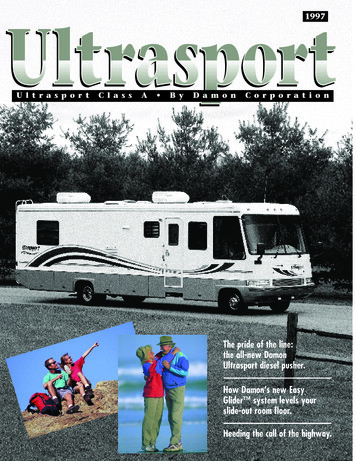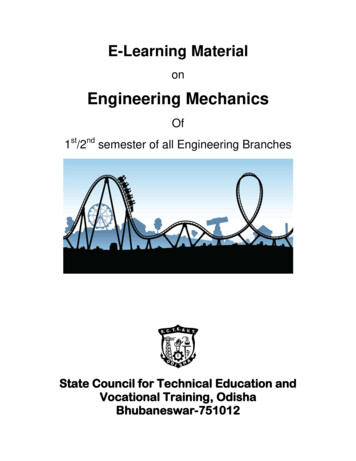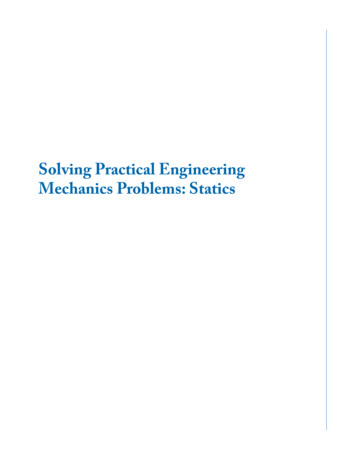
Transcription
bagden casi 1 e 2 rifo2-10-200611:58Pagina 133CHAPTER 4A. BagdenThe Damon System - SimplifiedMechanicsLow friction means more than just a passively ligatedbracket, it’s a whole philosophy that embraces mechanics,forces, biology and the high-tech materials to aid inaccomplishing superior results.To achieve consistently high standards, the fundamentalsof a low friction system have to be fully understood. This issomething we all struggle with in the early stages of using apassively ligated system, but if the Damon System philosophy is followed from the outset; these superior more efficiently treated cases can be obtained by all orthodontists.I came from an .018 system before I switched to TheDamon System, primarily because I have always been anadvocate of lighter forces. My thought being that forcesdelivered through a small slot would be lower than thosedelivered through a larger one. This indeed is not the case,and proved to be a great learning experience when I proceeded to test this phenomenon. I decided to perform atightly controlled, split mouth study on randomly selected,yet similar cases, using The Damon System on one side ofthe arch and conventional .018 on the other.The results were indisputably in favour of the DamonSystem, by the fact that the Damon side moved teethtwice as fast as the conventional side.This is due to two main factors; 1 - reduced friction by theremoval of an elastic or stainless steel tied ligature, 2 – theincreased wire-to-lumen ratio that reduces the binding andfriction between the bracket and the wire. These factorsenable more efficient levelling and aligning during theearly stages of treatment and more efficient slidingmechanics during the later stages. It must also be notedthat even torquing and rotational tooth movements occurmore rapidly when the low friction, passive Damon Systemis utilized.My treatment planning has been greatly impacted by theuse of The Damon System, and it is something for all clinicians to be aware of. The low forces allow the Damonarchwires, together with the passively ligated brackets, towork more in harmony with the patient’s individual biology.This has the effect of providing posterior transverse archdevelopment without the use of expanders. Space is created but in a way that is more “biologically friendly” andthe arch form is not pre-determined by an orthodontist orarchwire form. This, in my view, must be a more stable wayin treating cases, and this has been reflected within mypractice. I have also seen a dramatic reduction in theneed for extractions, which is a definite plus for my referringpractitioners, but more importantly I, along with a vastnumber of other Damon users, see such a positive effect onthe patient’s midface. The smiles are broader, the midfacesare fuller and aesthetics are exponentially improved. If,however, extractions will help the profile of the patient,such as bimaxillary protrusive cases, tooth size discrepancies or missing teeth, then I will extract. Facial aesthetics isthe primary determining factor.Anchorage is always a great concern with conventionalappliances, but when the Damon System and the protocolis followed, this is not an issue to consider. The anchoragedemands of the Damon System is far lower than conventional systems due to the considerably reduced frictionoffered by the passive lumen all Damon brackets possess. Ihave virtually abandoned the use of transpalatal archesand Nance holding arches within my practice, I find themnow more of a hindrance. If the molars are bound together by these appliances, then the posterior arch development I want to achieve with the Damon System is prevented and other means of gaining space have to be considered.I have found by using The Damon System and simplifyingmy mechanics, I can now breakdown my treatments intothree main phases of treatment –Phase I - Levelling and aligningArch development is initiated by the use of .014 DamonCopper NiTi or .013 Damon Copper NiTi if severe rotationsor periodontal issues are present. The aim of this phase is toresolve 90% of the rotations which should be accomplishedin 10-20 weeks. As I routinely have 10 weeks betweenappointments during this stage, this equates to 1 or 2 visits.It is essential that archwire stops are used to prevent wiresliding distally from the buccal tubes, always place theseanterior to crowding.Phase II - High tech edgewiseLeveling and aligning is completed and all remaining rotations are resolved. Torque control is initiated together withanterior space consolidation. Arch development is still progressing.The wires generally utilized are 14x25 then 18x25 DamonCopper NiTi. If a deep bite division 2 cases a 17x25 or 19x25Damon reverse curve NiTi is also a good option.A panorex is very often taken so I can see if any bracketsneed to be repositioned. The duration of this phase is usually from 10-20 weeks, but now I have 8 weeks in betweenappointments.Only move onto the next phase when a stainless steel wirecan be inserted passively.Phase III - Major mechanics and finishingTorque control is completed and all posterior space is consolidated by using tie backs which also prevent posteriorspace from re-opening.133
bagden casi 1 e 2 rifo2-10-200611:58Pagina 134CHAPTER 48 1/2 Months (4th visit)This is the time to fully coordinate the upper and lower archforms by copying the lower archform already present andmaking the upper archwire 1-2 mm larger all around thearch. If slightly more arch width is required, for example insome cross-bite cases, then the archwire may be expanded slightly at this point. Our testing has shown that by usingthis technique, the forces are still kept to a very low level.The duration of this phase is anything from 20-40 weeks with6 week appointment intervals for the major mechanics and4 week intervals for the finishing. This enables maximumtime management in your practice and to treat patients inthe shortest duration possible. I often find that 80% of mycases are 80% complete in 8 months, giving me the time tofinish to a high standard without excessively prolonging thetreatment.I would like to highlight some of the key benefits of theDamon System’s low force, low friction mechanics by sharing with you two cases that I would have definitely resortedto extraction and perhaps surgery, if I had been using myconventionally ligated bracket system.Upper 19x25 posted stainless steel, lower 16x25 posted steel.If all torques in the lower seem correct, there is no need toselect a 19x25 stainless steel wire, I often finish with 16x25 inthe lower, again keeping the forces as low as possible.Midline improving and vertical dimension is ideal. The periodontal tissue again seems much improved from the pretreatment photos.10 Months (5th visit)Maintain 19x25 and 16x25 posted stainless steel wires.Midline now coincidental and the planning of post treatment cosmetic bonding of upper lateral incisors begins.12 Months (6th visit)Debonding. Good periodontal situation and vertical relation2. CFAge: 18 yearsClinical Observations: Class III anterior open bite, bilateralcross bite, negative overjet, severe crowding present inthe upper, mild in the lower, low tongue positionPatients chief complaints: Strong lower jaw, cannot bite intofood (open bite), he has been told that he requires surgery, very much against the idea. Leaving the area in20 months.Treatment plan: Follow the Damon protocol, motivatepatient the essential need for elastic wear, which willalso help to disarticulate the bite. Consider surgery ifunsuccessful.CASE REPORT1. TMAge: 17 yearsClinical Observations: Severe crowding, active periodontalbreakdown, flat profile, poor oral hygiene, Class I, smallmaxillary lateral incisors, midline deviation and somethingelse to consider, a large nose.Patient’s chief complaints: crowded teeth, does not wantextractions (family members had extraction treatment anddid not look as good as before treatment had started!)Treatment plan: Start non-extraction, if periodontal conditionworsens extract OR discontinue treatment.Initial Bonding Case 2 – 11/02/03Again to use the optimal tooth moving forces, .014Damon Copper NiTi was utilized. I started running lightcross-bite elastics on the left side (A). I have found bydisarticulating in cross-bite cases, primarily using a Gelbappliance, or in this case letting the cross-elastics do thebite propping, I can correct cross-bites faster and moreefficiently. To ensure the lower molars would not supererupt during initial levelling, the archwire was not engaged into these brackets.Initial Bonding Case 1 - 8/21/02As for 80% of my cases, the initial wire utilized is a Damon.014 Copper NiTi. This archwire delivers the optimum forcelevels and allows the ideal wire-to-lumen ratio to produceminimum binding. What is also interesting about this wire isthe surface finish considerably smoother than the majorityof NiTi wires, to further reduce the friction and therefore theforce levels.Archwire stops have been placed between the lower central incisors and the upper canine and 1st bicuspid. Thisallows the maximum range of movement for the archwirewithout impeding tooth movement or causing excessivewire pokes.2 1/2 MonthsFirst visit back. The left cross-bite has been corrected. Itis worth noting the maxillary left first bicuspid has supererupted, this is due to the gingival position of thebracket. The upper crowding has started to work outnicely and the maxillary arch development can be seen.All molars now engaged and cross elastics started onthe right as well5 Months (3rd visit)Cross-bite corrected but still a strong Class III remains.Class III elastics are now started, together with anteriorbox elastics. The low force mechanics are providing theideal conduit to allow treatment to proceed with minimalintervention.5 Months (3rd visit)Dramatically improved periodontal situation and theexpected levelling and alignment after the .014 wire. 16x25Damon Copper NiTi placed in the upper, 14x25 in the lower.The difference between upper and lower wire dimensionsreflects the decreased inter-bracket distance that is present in the lower arch. This causes the relative stiffness of thewire to be increased in the lower, thus producing increasedforce levels which is something we strive to avoid.The lateral development can be seen, especially in thebicuspid region. This has allowed the crowding to berelieved BUT the anterior teeth have not dramaticallyflared. The light forces of the wire have allowed the musclepressure of the cheeks, tongue and lips, to balance theirposition.14 MonthsClass III and cross-bite is now corrected. Damon tie-backmodules are now placed and posterior box elastics arenow started. Also at this visit the maxillary bicuspids arenow repositioned.17 MonthsThe bite continues to improve. Box elastic wear is maintained. Note the better position of the upper left firstbicuspid.20 MonthsCompletion of treatment.134
bagden casi 1 e 2 rifo2-10-200611:58Pagina 135Case report 1Initial PhotosDuring the treatment135135
bagden casi 1 e 2 rifo2-10-200611:59Pagina 136Case report 1During the treatmentFinal Photos136
bagden casi 1 e 2 rifo2-10-200611:59Pagina 137Case report 2137137Initial Photos
bagden casi 1 e 2 rifo2-10-200611:59Pagina 138Case report 2138During the treatment
bagden casi 1 e 2 rifo2-10-200611:59Pagina 139Case report 2139139During the treatment
bagden casi 1 e 2 rifo2-10-200611:59Pagina 140Case report 2140Final Photos
ment I want to achieve with the Damon System is prevent-ed and other means of gaining space have to be consid-ered. I have found by using The Damon System and simplifying my mechanics, I can now breakdown my treatments into three main phases of treatment - Phase I - Levelling and aligning Arch development is initiated by the use of .014 Damon










